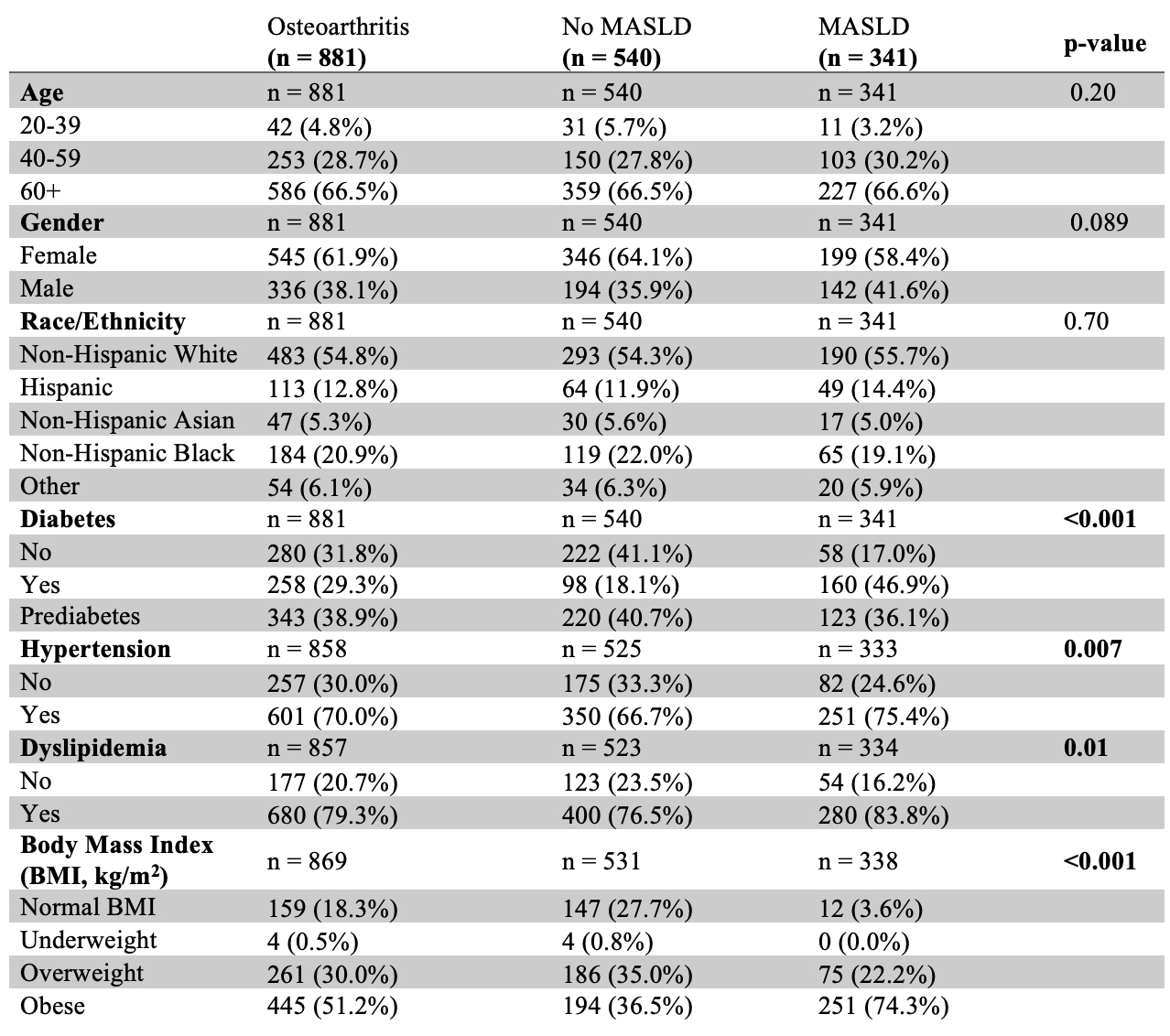Session Information
Session Type: Poster Session C
Session Time: 10:30AM-12:30PM
Background/Purpose: Steatotic liver disease (SLD) and osteoarthritis (OA) affect a large proportion of the general population and prevalence of both is expected to increase given the aging of the general population and their association with obesity. This study aimed to evaluate the prevalence of metabolic dysfunction-associated steatotic liver disease (MASLD), MetALD (new disease entity defined as metabolic dysfunction in combination with moderate weekly alcohol intake), alcohol-associated liver disease (ALD) among patients with OA. We also attempted to determine the prevalence of liver fibrosis among patients with OA.
Methods: Utilizing data from the U.S. National Health and Nutrition Examination Survey (NHANES) 2017-2020 cycle, we considered a median CAP score of ≥285 dB/m to diagnose SLD, a cut-off that provides an optimized sensitivity and specificity by Youden’s index to detect 5% steatosis. Significant fibrosis and advanced fibrosis were defined by using liver stiffness measurements (LSM) of >8.6 kPa and ≥13.1 kPa, respectively. Sample weights were applied to ensure representative estimates. Independent risk factors for these conditions among OA patients with MASLD were identified through multivariable logistic regression analysis. Adjusted odds ratios (aORs) and 95% confidence intervals (CIs) are presented.
Results: Among the 881 patients with self-reported OA, the majority were aged 60 and above (66.5%), were female (61.9%), and of non-Hispanic white ethnicity (54.8%). MASLD was more prevalent in individual’s with obesity (BMI ≥ 30), diabetes, dyslipidemia, and hypertension, with all showing statistically significant differences (p-values shown in Table). Age, gender and race and ethnicity did not demonstrate a statistically significant difference between the MASLD and non-MASLD groups. The age-adjusted prevalence of MASLD, MetALD and ALD were 33.27% (95% CI: 24.20-43.79%), 0.83% (95% CI: 0.38-1.80%) and 0.67% (95% CIL 0.12-3.50%), respectively. Furthermore, the age-adjusted prevalence of significant fibrosis and advanced fibrosis was 11.36% (95% CI: 6.11-20.16%) and 6.14% (95% CI: 2.73-13.22%), respectively. Notably, OA patients with MASLD demonstrated a higher likelihood of having diabetes (aOR 3.65; 95% CI: 1.50-8.88), dyslipidemia (aOR 2.84; 95% CI: 1.42-5.68) and a BMI >30 kg/m2 (aOR 23.44; 95% CI: 8.24-66.70).
Conclusion: There is high prevalence of MASLD and liver fibrosis among patients with OA and high correlation of both, with several systemic diseases such as obesity, diabetes, and cardiovascular disease. A comprehensive approach to early detection and treatment of SLD in OA patients with comorbidities is crucial for reducing potential adverse health outcomes. Future research should explore new ways to decrease the inflammatory state seen with SLD in this patient population. GLP-1 receptor agonists could provide such therapeutic options, as they have shown promising data on osteoarthritis and MASH. Similarly, management of other co-morbidities seen in OA (obesity, diabetes) may improve MASH. Finally, further studies are needed to quantify the risk of SLD stratified by the cumulative dose of non-steroidal anti-inflammatory drugs (NSAIDs) among patients with OA.
Patient Baseline Characteristics
Prevalence of Steatotic Liver Disease and Liver Fibrosis Among US Adults with Osteoarthritis (OA).
To cite this abstract in AMA style:
Vassilopoulos A, Vassilopoulos S, Kalligeros M, Mylonakis E, Reginato A. Prevalence of Steatotic Liver Disease and Liver Fibrosis Among Patients with Osteoarthritis (OA) [abstract]. Arthritis Rheumatol. 2024; 76 (suppl 9). https://acrabstracts.org/abstract/prevalence-of-steatotic-liver-disease-and-liver-fibrosis-among-patients-with-osteoarthritis-oa/. Accessed .« Back to ACR Convergence 2024
ACR Meeting Abstracts - https://acrabstracts.org/abstract/prevalence-of-steatotic-liver-disease-and-liver-fibrosis-among-patients-with-osteoarthritis-oa/


